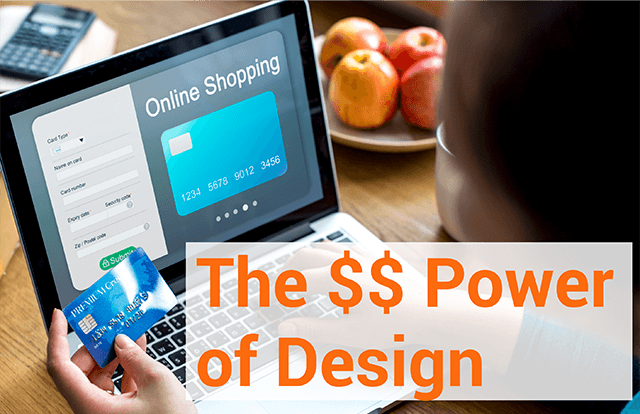If you operate an e-commerce site, this post will show you how to you can use the $$ power of design to convert your e-commerce visitors into buyers.
In a recent post, I talked about the crucial importance of the first two screens of the homepage of commercial websites for communicating a compelling value proposition. A 2018 Neilson Norman Group study found that users spend 74% of their time in this introductory space. The takeaway? If site visitors can’t find a compelling value that causes them to stick around a site, they don’t.
While the study covered a wide range of site types, it did not drill down into the unique requirements of product e-commerce sites. Let’s do that here.
Yes…but
An e-commerce site may start with the same broad requirement as service sites to position value messages front and center. There are enough usage peculiarities though that demand you take a more refined approach to value language positioning.
Online shoppers are hyper-focused.
 Because the online consumer’s objective is concrete and time-limited, many shoppers use the first search function they see to bypass the home page entirely. As a result, if you want to communicate an important competitive advantage, you must do so immediately upon home page load. Your site’s first screen is the place for your competitive best foot forward. Don’t rely on users scrolling down.
Because the online consumer’s objective is concrete and time-limited, many shoppers use the first search function they see to bypass the home page entirely. As a result, if you want to communicate an important competitive advantage, you must do so immediately upon home page load. Your site’s first screen is the place for your competitive best foot forward. Don’t rely on users scrolling down.
Consumer focus has another consequence; the screen space surrounding a specific product is far more important than your home page for communicating value propositions that will impact a shopper’s willingness to act immediately.
Your value proposition must be adjacent to the product information.
Consumers are not going to work hard to uncover your unique value proposition. They may scroll down a bit, and they may click on one link (mainly to check reviews), but they won’t chase the answers too far before they decide that your site is too difficult. Negative experience with a site such as usability and poor page load times account for the vast majority of page bounces.
Consumers are looking for a reason to buy from you, not just product specs.
 The decision to buy has more to do with you than the product. The vast majority of consumers research products on multiple sites before they buy (85%). It is highly likely that a user will land on your virtual doorstep knowing a product’s specs, industry reviews, general availability, and of course, the current market price.
The decision to buy has more to do with you than the product. The vast majority of consumers research products on multiple sites before they buy (85%). It is highly likely that a user will land on your virtual doorstep knowing a product’s specs, industry reviews, general availability, and of course, the current market price.
Once a shopper determines that your product is the exact version they are seeking and that your price and delivery are competitive, their main objective is to identify whether you offer enough competitive value for them to place the order here and now.
Before a consumer pulls the trigger, they need reassurance that you are a desirable resource.
Here is a brief list of elements that might sway that decision:
- Offsetting Value. Don’t make them search for the value proposition you believe will beat your competitors. Highlight it (e.g., “In Stock and Available Now!”). Consumers will give up a purchase goal in exchange for a more desirable one. They will give up a low price for faster delivery. They will give up fast delivery for an extraordinary favorable price. They will give up both for availability when others are out of stock.They can’t make that trade-off if they can’t find the information.
- Social Proof. You know the value of social proof. Don’t make people search for reviews and testimonials. Take a page from Amazon and make them available on the same page with a swift link to jump to them.
- Human Contact. Humanize your staff and make it easy for a shopper to contact them before and after the purchase. Consumers trust companies that are easy to reach.
- Competitive Return Policy. People want to know if they can return something before they buy it. Don’t you?
- Costs Known Upfront. An unexpected extra cost is the number one reason that shoppers abandon carts. You might think you can capture a buyer once they start the purchase process – you won’t if you surprise them.
Your goal is not to overload the buyer, but to carefully position value proposition language where it will do you the most good. This almost always is on the screen your buyers on – not another they must click through to see.
Site design isn’t magic. It won’t turn an uncompetitive product into a winner, but it has the power to ensure your users get the reassurance they need to choose you if you are a bona fide competitive choice.
Looking for more statistics? I recommend this report from Oberlo:




